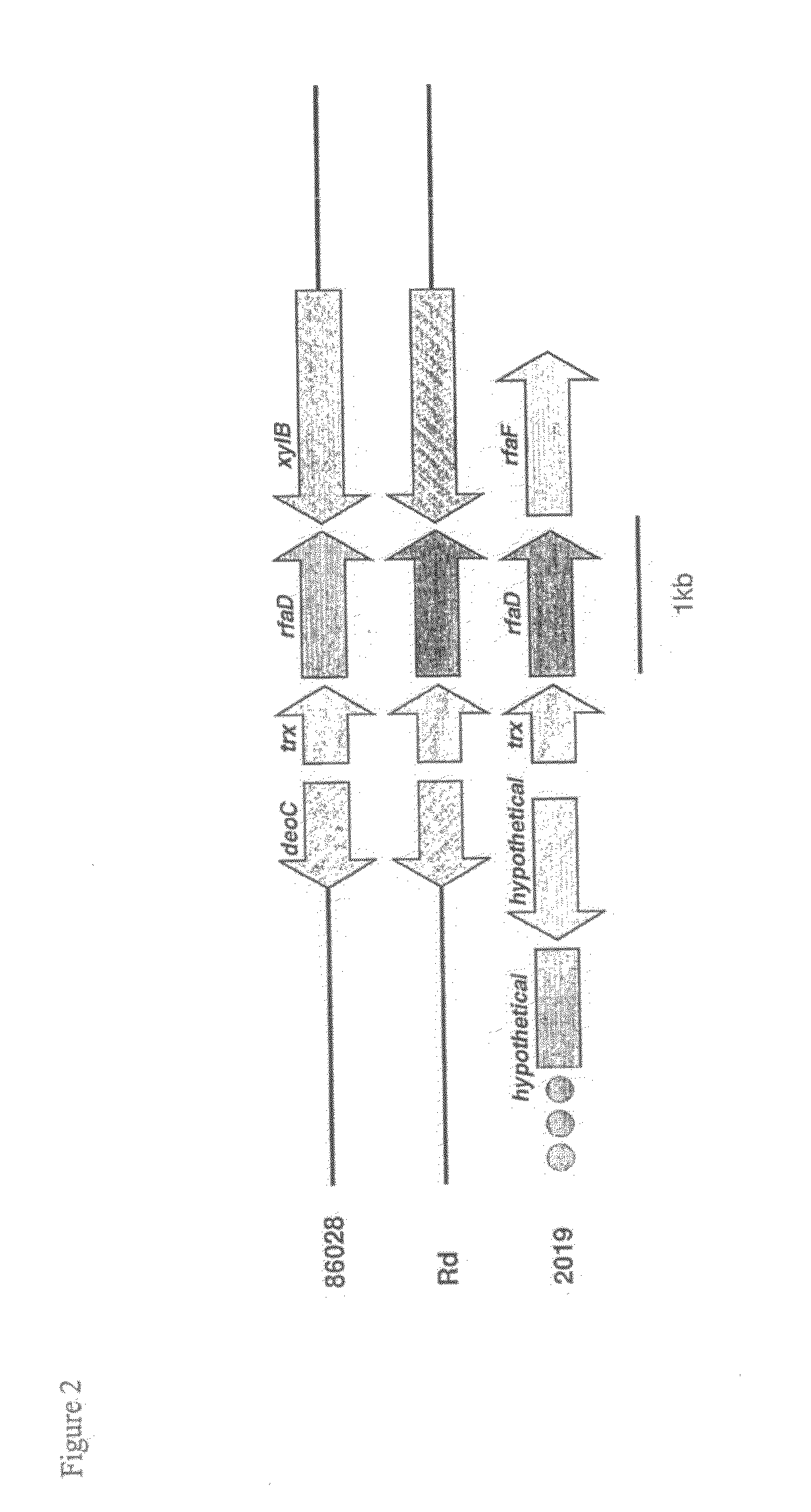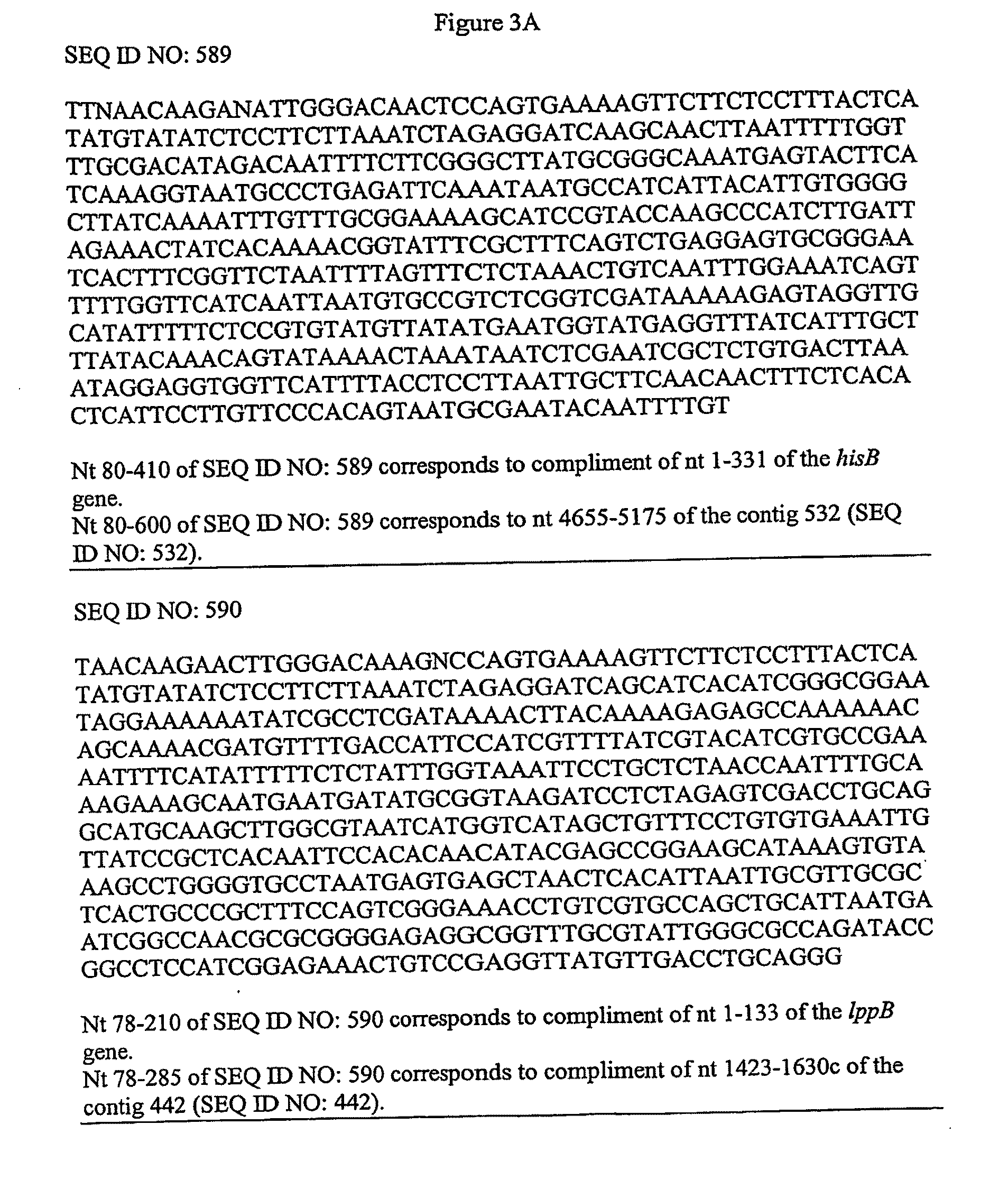Genes of an Otitis Media Isolate of Nontypeable Haemophilus influenzae
a technology of haemophilus influenzae and genome, which is applied in the field of polynucleotide sequence of a nontypeable strain of haemophilus influenzae (nthi) genome, can solve the problems of om coverage being disappointing, affecting the development of effective vaccines, and too being met with criticism, so as to prolong the presence of peptide-like therapeutic agents, increase the use of pharmaceutical arts, and rapid breakdown or denaturation
- Summary
- Abstract
- Description
- Claims
- Application Information
AI Technical Summary
Benefits of technology
Problems solved by technology
Method used
Image
Examples
example 1
Sequence of a Non-Typeable Haemophilus influenzae Genome
[0082]NTHi strain 86-028NP is a minimally passaged clinical isolate obtained from a pediatric patient who underwent tympanostomy and tube insertion for chronic OM at Columbus Children's Hospital. (Bakaletz et al. Infection and Immunity, 56(2): 331-335, 1988) The 86-028NP strain was deposited with the American Type Tissue Collection (Manassas, Va. 20108 USA) on Oct. 16, 2002 and assigned accession no. PTA-4764.
[0083]In an effort to more broadly approach the identification of the virulence determinants in NTHi, the genome of the NTHi 86-028NP strain was sequenced to 3-fold coverage. Chromosomal DNA was prepared from strain 86-028NP using the Puregene protocol and sheared to 2-4 kb in size with a Hydroshear instrument (Gene Machines). The sheared DNA was ethanol-precipitated, end-repaired using a mixture of Klenow enzyme and T4 DNA polymerase, and size-selected by agarose gel electrophoresis to obtain 2-4 kb fragments as described...
example 2
Contig Description and Initial Gene Discovery
[0087]Seventy-five of the 88 contigs with length ≧5000 bp, identified with the 3-fold sequence analysis, show significant similarity via BLASTN to genes in H. influenzae strain Rd. To visualize the potential relationship between the gene order in H. influenzae strain 86-028NP and H. influenzae strain Rd, the 86-028NP three-fold contig set and the Rd gene set were bidirectionally compared using BLASTN. The results were plotted in gene-order verses contig space by sorting the contigs based on gene coordinates of the Rd genes hit, anchoring each contig at the smallest coordinate found as described in Ray et al., (Bioinformatics 17: 1105-12, 2001). Compared in this fashion, an incomplete assembly of a genome with identical gene order to a completely known genome would display a monotonically increasing stair-stepped form.
[0088]BLASTX was used to identify hits to sequences with homology to genes in the strain Rd genome as well as genes not fou...
example 3
Construction of the NTHi Promoter Trap Library
[0093]To identify potential virulence determinants of NTHi, bacterial gene expression was monitored by differential fluorescence induction (DFI) during early disease progression in one specific anatomical niche of a chinchilla model of NTHi-induced otitis media (OM). Genomic DNA fragments from NTHi strain 86-028NP were cloned upstream of the promoterless gfpmut3 gene using a promoter trap library. Plasmid pGZRS39A, a derivative of pGZRS-1 isolated from Actinobacillus pleuropneumoniae, is an A. pleuropneumoniae-Escherichia coli shuttle vector. This plasmid contains the origin of replication from A. pleuropneumoniae, the lacZα gene from pUC19 and the kanamycin resistance gene from Tn903. (West et al., Genes, 160: 81-86, 1995).
[0094]The promoter trap vector was constructed by cloning the GTP mutant gfpmut3 gene, as a BamHI to EcoRI fragment into pGZRS-39A to form pRSM2167. This mutant GTP gene contains two amino acid changes, S65G and S72A,...
PUM
 Login to View More
Login to View More Abstract
Description
Claims
Application Information
 Login to View More
Login to View More - R&D
- Intellectual Property
- Life Sciences
- Materials
- Tech Scout
- Unparalleled Data Quality
- Higher Quality Content
- 60% Fewer Hallucinations
Browse by: Latest US Patents, China's latest patents, Technical Efficacy Thesaurus, Application Domain, Technology Topic, Popular Technical Reports.
© 2025 PatSnap. All rights reserved.Legal|Privacy policy|Modern Slavery Act Transparency Statement|Sitemap|About US| Contact US: help@patsnap.com



